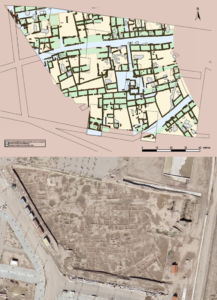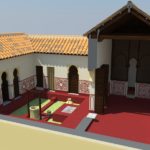
The Houses

The data collected in some cities of Andalusia, and especially in the large suburb that developed from the eighth century in the south of the Guadalquivir, in the current district of Miraflores, show transitional housing between the previous ancient world and the later city of Calipha. In them the rooms and patios are hardly defined, and there are no private latrines or water wells.

From the 10th century the city is fully Islamized and the Andalusian “house-patio” is imposed, a dwelling adapted to a Muslim inhabitant in which privacy and hygiene acquire a fundamental role. In this house all the rooms revolve around a central patio, which serves to illuminate, ventilate and communicate the rest of the rooms; and that avoids opening windows to the exterior to preserve family intimacy. Only warehouses, stables, shops or workshops could be isolated from the domestic interior, mainly for reasons of hygiene and privacy.

The protection of family privacy is enhanced by the provision of an intermediate space between the street and the patio: the hallway, which makes it difficult for people to have a vision of the interior of the house. The living room was a room covered with a rectangular floor plan and one or two compartmented bedrooms at the ends. Next to the patio, which was the most important and best decorated space, as seen in the paintings that used to adorn its walls? The patio generally had plant elements and fountains, and often with a well of water that supplied the house. The vast majority of these “patio-houses” also had their own latrine: a small rectangular space dedicated to hygiene that evacuated the waste to a sewer network or to a black hole open on the street.
Bibliography
BLANCO GUZMÁN, R. (2014): “La Córdoba tardoislámica y su arquitectura doméstica”, en SABATÉ, F.; BRUFAL, J. (dirs.): La Ciutat Medieval i Arqueologia. VI Curs International d’Arqueologia Medieval. Lleida, pp. 381-397.
BLANCO GUZMÁN, R. (2014): La arquitectura doméstica tardoislámica de Qurtuba (ss. XII-XIII). Universidad de Córdoba. http://helvia.uco.es/xmlui/handle/10396/12212
BLANCO GUZMÁN, R.(2014): “Una ciudad en transición: el inicio de la Córdoba islámica”, en VAQUERIZO, D. (dir.): Ciudad y territorio: transformaciones materiales e ideológicas entre época clásica y el Altomedioevo, Córdoba, pp. 185-200.
CÁNOVAS, A.; CARMONA, S.; RIVERA, R. (2007): “Las pinturas almohades del Palacio de Orive (Córdoba, España)”, en Actas del IX Congreso Internacional de la Association Internationale pour la Peinture Murale Antique, Zaragoza. pp. 491-494.
CÁNOVAS, Álvaro; CASTRO, Elena; MORENO, Maudilio (2008): “Análisis de los espacios domésticos en un sector de los arrabales occidentales de “Qurtuba””, Anejo de Anales de Arqueología Cordobesa, 1, pp. 201-219
CASAL GARCÍA, M. T.(2008): “Características generales del urbanismo cordobés de la primera etapa emiral: el Arrabal de “Šaqunda””, Anejos de Anales de Arqueología Cordobesa, 1, pp. 109-134.
CASAL, M. T.; MARTÍNEZ, Rafael; CASAL ARAQUE, María del Mar (2009-2010): “Estudio de los vertederos domésticos del arrabal de Šaqunda: Ganadería, alimentación y usos derivados (750-818) (Córdoba)”, en Anejos de Anales de Arqueología Cordobesa, 2, pp. 143-182.
DORTEZ, T. (2010): “Urbanismo islámico en el sector central del Ŷānib al-Garbī”, en VAQUERIZO GIL, D.; MURILLO REDONDO, J. F.: El anfiteatro romano de Córdoba y su entorno urbano. Análisis arqueológico (ss. I-XIII). Vol. 2, pp. 621-628.
FUERTES, C. (2007): “El sector noroccidetal del arrabal califal del yacimiento de Cercadilla: análisis urbanístico y arquitectónico”, Arqueología y Territorio Medieval, 14, pp. 49-68.
FUERTES, C.; MURILLO, J. F.; LUNA, D. (2003): “La cerámica almohade del Palacio de Orive en Córdoba”, en VIIe Congrès International sus la Céramique Médievale en Méditerranée, pp. 683-684.
VÁZQUEZ NAVAJAS, B. (2010): “La gestión del agua en los arrabales occidentales de Madīnat Qurṭuba”, en VAQUERIZO GIL, D.; MURILLO REDONDO, J. F.: El anfiteatro romano de Córdoba y su entorno urbano. Análisis arqueológico (ss. I-XIII), vol. 2, pp. 643-651.
VÁZQUEZ NAVAJAS, B. (2016): Arqueología hidráulica en los arrabales occidentales de la Córdoba omeya. Universidad de Córdoba, UCOPress (Tesis Doctoral).

